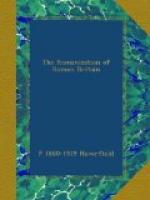I need not here insert a sketch of Roman Britain. But I may call attention to three of its features which are not seldom overlooked. In the first place, it is necessary to distinguish the two halves of the province, the one the northern and western uplands occupied only by troops, and the other the eastern and southern lowlands which contained nothing but purely civilian life.[1] The two are marked off, not in law but in practical fact, almost as fully as if one had been domi and the other militiae. We shall not seek for traces of Romanization in the military area. There neither towns existed nor villas. Northwards, no town or country-house has been found beyond the neighbourhood of Aldborough (Isurium), some fifteen miles north-west of York. Westwards, on the Welsh frontier, the most advanced town was at Wroxeter (Viroconium), near Shrewsbury, and the furthest country-house an isolated dwelling at Llantwit, in Glamorgan.[2] In the south-west the last house was near Lyme Regis, the last town at Exeter.[3] These are the limits of the Romanized area. Outside of them, the population cannot have acquired much Roman character, nor can it have been numerous enough to form more than a subsidiary factor in our problem. But within these limits were towns and villages and country-houses and farms, a large population, and a developed and orderly life.
[Footnote 1: For further details see the Victoria County Histories of Northamptonshire, i. 159, and Derbyshire, i. 191. To save frequent references, I may say here that much of the evidence for the following paragraphs is to be found in my articles on Romano-British remains printed in the volumes of this History. I am indebted to its publishers for leave to reproduce several illustrations from its pages. For others I refer my readers to the History itself.]
[Footnote 2: See my Military Aspects of Roman Wales, notes 60 and 82. There was some sort of town life at Carmarthen.]
[Footnote 3: The Roman remains discovered west of Exeter are few and mostly later than A.D. 250. No town or country-house or farm or stretch of roadway has ever been found here. The list of discoveries includes only one early settlement on Plymouth harbour, another near Bodmin, of small size, and a third, equally small and of uncertain date, on Padstow harbour; some scanty vestiges of tin-mining, principally late; two milestones (if milestones they be) of the early fourth century, the one at Tintagel church and the other at St. Hilary; and some scattered hoards and isolated bits. Portions of the country were plainly inhabited, but the inhabitants did not learn Roman ways, like those who lived east of the Exe. Even tin-mining was not pursued very actively till a comparatively late period, though the Bodmin settlement may be connected with tin-works close by.]
[Illustration: FIG. 1. THE CIVIL AND MILITARY DISTRICTS OF BRITAIN.]




